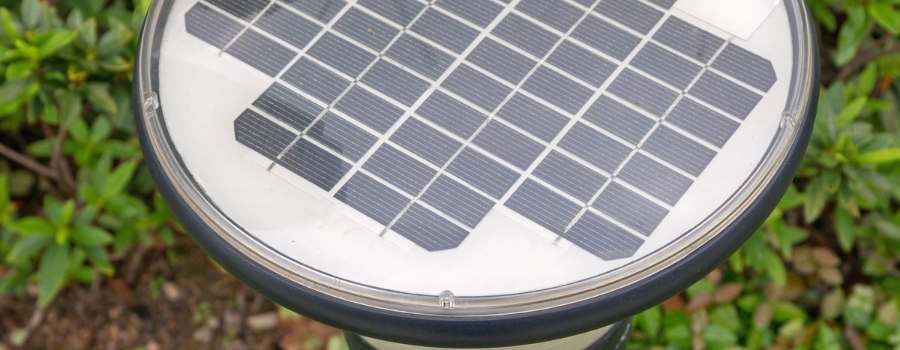
When it comes to solar lights, there’s a lot of information out there…but there are always little factoids and “ninja tips” that seem to not get passed around as often as they should. While I think you could probably scour the internet and troubleshooting manuals and find these tidbits of information I know it will be much more helpful to compile it into one place.
If you’re interested in purchasing solar lighting I have several articles on this site that covers a wide range of topics, but here are a few little nuggets of info that may be helpful if you’ve already made a purchase!
Can Solar Light Sensors Be Cleaned?
In general, cleaning the sensors on your solar lights is a great idea that should be done fairly regularly. Cleaning dirt and grime off your solar light sensors every 3 months will maximize their effectiveness. That way, they’ll have a much longer lifespan overall.
Solar light sensors sit inside a hard outer shell. The manufacturers who make them typically use clear plastic or glass that does a fantastic job protecting the component inside, even when you clean the sensor thoroughly.
You should avoid scrubbing solar light sensors too hard despite that hard outer shell. Applying too much pressure will damage the solar light sensors and cause you more problems.
So, when cleaning solar light sensors, use gentle cleaning supplies like:
- A damp cloth.
- A dishwashing sponge.
- Dishwashing soap.
You can start by using a damp cloth to wipe away any loose dirt on the solar light sensor. Next, you can clean more stubborn stains with dishwashing soap and a sponge for gentle scrubbing.
In more severe cases, you can use sandpaper to gently sand away all grime and dirt stuck on the surface of your solar light sensors. However, you should do so very carefully to avoid damaging those sensors.
In most cases, a 3-month interval is enough to keep your solar light sensors clean and working efficiently. Still, there are some cases when you should do it more often.
For example, solar lights under tree branches will often get covered with leaves, small branches, and tree sap. As a result, you’ll have to clean the sensors on those lights more frequently.
Where Is The Light Sensor On A Solar Light?
Typically, you’ll usually find a solar light sensor somewhere close to the lightbulb or LED itself. The sensor’s placement isn’t standardized, which means that it might be in very different places depending on the light’s design.
For example, some manufacturers place the sensor on the solar panels themselves. Others might place it around the solar light’s frame or close to the light itself.
Here are three other ways to find the light sensor on your solar light:
#1) Inspect Your Solar Light Closely
To locate and identify the sensor, look for a part that resembles an eye or a tiny ball. The sensor should be on the part of the light that has a clear view of whether it’s bright or dark out.
#2) Cover The Part You Think Is The Sensor
If you think you’ve found the sensor but aren’t sure, you can quickly test it. Just cover the part you feel is the sensor with your finger and see if the solar light turns on. Covering the sensor will trick it into thinking it’s nighttime, causing it to turn on the solar light.
#3) Check The Solar Light Packaging Or Documentation
Lastly, you can also find the light sensor by referring to the packaging, user manual, or any technical sheet that might have come with the light. Those documents typically include diagrams that clearly show you where to find the solar light sensor.
Can Solar Light Sensors Be Replaced?
Generally, you can replace a solar light sensor if it’s faulty or no longer working at all. However, it’s essential to understand that the process will differ slightly depending on the solar light brand and model.
Still, here are the general steps that you must follow to get the job done:
- Get A Suitable Replacement – You’ll have to get a new solar light sensor to replace the faulty one you have, for starters. Ideally, you should get an identical replacement so that it fits perfectly with your solar light.
- Still, you might find that those are unavailable. In that case, shop around carefully for a new sensor that’s compatible with your light brand and model.
- Remove Existing Sensor – Once you have the replacement sensor in your hands, you can begin removing the faulty sensor in your solar lights. You’ll likely require a screwdriver and some basic tools to open the light’s frame and access the light sensor.
- Again, the precise steps will differ depending on your solar light model. For example, you might have to unthread screws holding the faulty sensor or free it from clips that hold it in place.
- Remove Wire Connectors – Be sure to gently remove the wire connectors attached to the solar light sensor.
- Connect Wiring To New Sensor – After removing the faulty parts, you can reconnect the wiring to the new light sensor the same way as the old one.
- Fit New Sensor Into Place – Next, secure the new sensor to the solar light, whether that’s with screws or plastic clips.
- Test Your Sensor – Lastly, test the new sensor to ensure that it works correctly. You can do so by covering the sensor, triggering it to turn on the solar light.

Do Solar Light Sensors Need Direct Sunlight?
No, solar light sensors do not need direct sunlight to work. Instead, these kinds of sensors rely only on ambient light.
For instance, when there’s little ambient light at dusk, the sensor will understand that it’s getting dark and activate your solar lights. That’s why covering the sensor with your finger will cause the solar light to turn on, regardless of what time of day it is.
On the other hand, bright ambient light in the day will trigger the sensor to shut off the solar light.
Will Solar Light Sensors Detect Artificial Light?
In general, solar light sensors will detect artificial light and can even charge the light’s battery. However, since the lumens provided by artificial light are much lower than what is provided by natural sunlight your solar lights will charge much more slowly and the bulbs likely won’t burn as bright.
That’s why the placement of your solar lights is quite essential. These lights shouldn’t be placed too close to any artificial lights sources that will affect their regular operation.
For example, people typically place solar lights out in their garden where there is no conventional lighting. However, placing them under a street lamp or too close to your household’s outdoor lighting will prevent them from turning on even when it’s dark out.
The reason for that is pretty straightforward, the solar light sensors think that it’s daytime because they’re picking up on the artificial lighting.
For information on charging solar lights on cloudy days, check out this article!
Batteries In Solar Lights: 9 Questions Answered
Why Do Solar Lights Have An On And Off Switch? We Find Out
